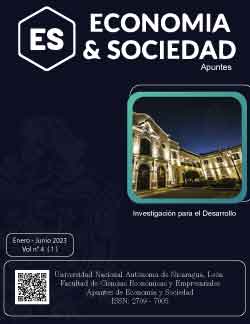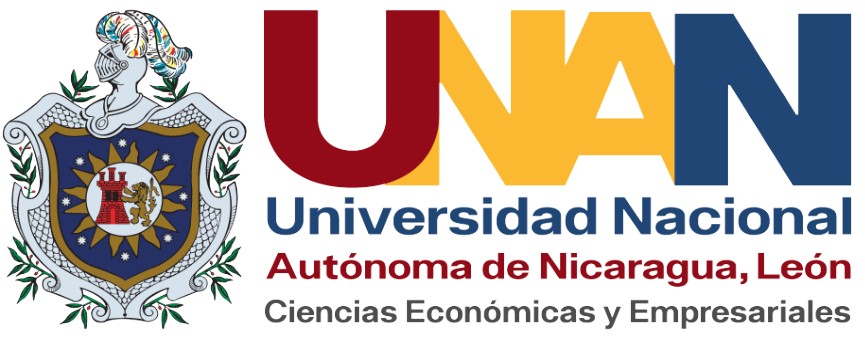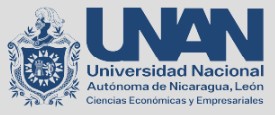Dinámica de la cadena de producción del bocadillo veleño: un acercamiento desde el desarrollo local
DOI:
https://doi.org/10.5377/aes.v4i1.16165Palabras clave:
competitividad, asociatividad, cadena productiva, desarrollo local, bocadillo veleñoResumen
El bocadillo veleño es un manjar que se disfruta desde varias generaciones; más allá de su valor cultural, fomenta el desarrollo económico y social a nivel local. El presente escrito realiza un aporte mediante una aproximación a la cadena de valor de este producto contemplando sus eslabones constitutivos a modo de taxonomía. Mediante una investigación de tipo descriptivo, se realiza un breve análisis en diez empresas productoras de bocadillo ubicadas en los municipios de Vélez, Barbosa y Moniquirá sobre aspectos de constitución organizacional, competitividad, asociatividad, exportación, tecnología e innovación. Sumado a ello un acercamiento a la dinámica de los otros eslabones presentes en la cadena: cultivadores y transformadores de hoja de bijao, productores de guayaba y organismos que se encargan de agremiar a los agentes presentes. Como principal resultado se observa un análisis de elementos que constituyen valor en la cadena, el rol del territorio en el desarrollo local y el papel de sus agentes productivos. No obstante, a pesar de los esfuerzos del sector, falta un mayor grado de fortalecimiento, por lo que la academia podría fungir como un actor clave de apoyo.
Descargas
Citas
Alpaslan, B., & Ali, A. (2016). The spillover effects of innovative ideas on human capital. CAMA Working Papers, (59), 1-31. https://dx.doi.org/10.2139/ssrn.2841075
Andersson, T., Schwaag, S., Sörvik, J., & Wise, E. (2004). The cluster, policies whitebook. Malmö: IKED.
Bada, L., Rivas, L., & Littlewood, H. (2017). Model of associativity in the production chain in agroindustrial SMEs. Contaduría y Administración, 62(4), 1118-1135. https://doi.org/10.1016/j.cya.2017.06.006
Bedregal, A. (2014). La asociatividad como factor de sostenibilidad en asociaciones de productores agrícolas y agroindustriales. Revista de la Universidad del Valle de Guatemala, (27), 93-104. https://www.academia.edu/35044260/La_asociatividad_como_factor_de_sostenibilidad_en_asociaciones_de_productores_agricolas_y_agroindustriales
Bermejo, R. (2011). Manual para una economía sostenible. Madrid: Catarata.
Cáceres, L., Pardo, C., & Torres, A. (2012). La asociatividad en la dinámica productiva del municipio de El Yopal, Casanare. Gestión & Sociedad, 5(2), 37-50. Recuperado de https://ciencia.lasalle.edu.co/gs?utm_source=ciencia.lasalle.edu.co%2Fgs%2Fvol5%2Fiss2%2F3&utm_medium=PDF&utm_campaign=PDFCoverPages
Ceballos, R., & García, I. (2013). Protección legal de las denominaciones de origen y las marcas frente a los tratados de libre comercio suscritos por Colombia. Revista prolegómenos - derechos y valores, 16(32), 175-189. Recuperado de http://www.scielo.org.co/scielo.php?script=sci_arttext&pid=S0121-182X2013000200011
Chaithanapat, P., Punnakitikashem, P., Khin, N. C., & Rakthin, S. (2022). Relationships among knowledge-oriented leadership, customer knowledge management, innovation quality and firm performance in SMEs. Journal of Innovation & Knowledge, 7(1). https://doi.org/10.1016/j.jik.2022.100162
Coral, C., & Mithöfer, D. (2023). The backbone of agrifood value chain resilience: Innovation in the Ecuadorian banana value chain from a historical perspective. World Development Perspectives, 29. https://doi.org/10.1016/j.wdp.2022.100476
Coronado, A., Echeverri, A., & Arias, J. (2014). Aproximación a la cooperación en innovación en empresas del programa de asociatividad y desarrollo empresarial sectorial -Pades- en Antioquia (Colombia). Revista Facultad Ciencias Económicas, 22(2), 185-205. Recuperado de https://ideas.repec.org/s/col/000180.html
Deschamps, I., Macedo, M., & Eve-Levesque, C. (2013). University-SME collaboration and open innovation: intellectual-property management tools and the roles of intermediaries. Technology innovation management review, 3. (3), 33-41. http://dx.doi.org/10.22215/timreview/668
Dubey, U. K., & Kothari, D. P. (2022). Research Methodology, Technique and Trends. Boca Raton: Chapman and Hall/CRC. https://doi.org/10.1201/9781315167138
Eiriz, V. (2020). Spatial proximity and SME strategy in local networks. Journal of Business & Industrial Marketing, 35(2), 338-348. https://doi.org/10.1108/JBIM-10-2018-0283
Elikem, C., Akaba, S., & Worwui-Brown, D. (2014). Globalization and competitiveness: challenges of a small and medium enterprises (SMEs) in Accra, Ghana. International Journal of Business and Social Science, 5(4), 1-10. Recuperado de https://ir.ucc.edu.gh/xmlui/bitstream/handle/123456789/4317/Globalization%20and%20Competitiveness-Challenges%20of%20Small%20and%20Medium%20Enterprises.pdf?sequence=1&isAllowed=y
Mitra, S. K., Irenaeus, T.K.S., Gurung, M. R. and Pathak, P. K. (2012). Taxonomy and importance of Myrtaceae. Acta Hortic. 959, 23-34
https://www.actahort.org/books/959/959_2.htm#:~:text=10.17660/ActaHortic.2012.959.2
Falahat, M., Ramayah, T., Soto-Acosta, P., & Lee, Y. Y. (2020). SMEs internationalization: The role of product innovation, market intelligence, pricing and marketing communication capabilities as drivers of SMEs’ international performance. Technological Forecasting and Social Change, 152. https://doi.org/10.1016/j.techfore.2020.119908
Farinha, L., Matos, J., & Borges, J. (2014). Innovation and competitiveness: a high-tech cluster approach. The Romanian Review Precision Mechanics, Optics & Mechatronics, (45), 41-48. Recuperado de https://www.researchgate.net/publication/267153595_Innovation_and_Competitiveness_A_High-Tech_Cluster_Approach
Fátima, M., Sousa, C., Sheikh, F. A., & Novikova, M. (2023). Social innovation and rural territories: Exploring invisible contexts and actors in Portugal and India. Journal of Rural Studies, 99, 204-212. https://doi.org/10.1016/j.jrurstud.2021.04.013
Ghauri, S., Mazzarol, T., & Soutar, G. N. (2021). Why do SMEs join Co-operatives? A comparison of SME owner-managers and Co-operative executives views. Journal of Co-operative Organization and Management, 9(1). https://doi.org/10.1016/j.jcom.2020.100128
Grueso, M., Gómez, J., & Garay, L. (2011). Redes empresariales e innovación: el caso de una red del sector cosmético en Bogotá (Colombia). Estudios Gerenciales, 27(118), 189-203. Recuperado de http://www.scielo.org.co/pdf/eg/v27n118/v27n118a10.pdf
Gualdrón, L., & Jiménez, P. (2006). Retención de nutrientes en bocadillos de guayaba (Psidium guajava) y feijoa (Acca sellowiana) elaborados en vapor al vacío y a presión atmosférica. Revista de Investigación Universidad de La Salle, 6(2), 171-177. Recuperado de http://redalyc.uaemex.mx/
Herbert, T., & Larsen, P. (1985). Leaf movement in Calathea lutea (Marantaceae). Oecologia, 67(1985), 238-243. Recuperado de https://www.jstor.org/stable/4217721
Kaya, O. (2022). Determinants and consequences of SME insolvency risk during the pandemic. Economic Modelling, 115. https://doi.org/10.1016/j.econmod.2022.105958
Keijser, C., Belderbos, R., & Goedhuys, M. (2021). Governance and learning in global, regional, and local value chains: The IT enabled services industry in South Africa. World Development, 141. https://doi.org/10.1016/j.worlddev.2021.105398
Londoño, J. (2009). La denominación de origen y el alcance de su protección. Revista La propiedad inmaterial, (13), 41-58. Recuperado de https://revistas.uexternado.edu.co/index.php/propin/article/view/456
Lozano, M. (2010). Modelos de asociatividad: estrategias efectivas para el desarrollo de las pymes. (68), 175-178. Recuperado de https://www.redalyc.org/articulo.oa?id=20619844015
Makedos, I. (2014). The collaboration of SMEs through clusters as defense against economic crisis. Economics Research International, (6), 1-9. http://dx.doi.org/10.1155/2014/407375
Manole, D., Nisipeanu, E., & Decuseară, R. (2014). Study on the competitiveness of small and medium-sized enterprises (SMEs) in Vâlcea County. Theoretical and applied economics, 593(4), 113-130. Recuperado de https://econpapers.repec.org/scripts/redir.pf?u=http%3A%2F%2Fstore.ectap.ro%2Farticole%2F975.pdf;h=repec:agr:journl:v:xxi:y:2014:i:4(593):p:113-130
Marín, O., Cotes, I., Carreño, M., & Hernández, A. (2014). Estudio de oferta y demanda de la guayaba en la región del Río Suarez. I+D Revista de Investigaciones, 4(2), 49-58. https://doi.org/10.33304/revinv.v04n2-2014005
Markus, G., & Rideg, A. (2021). Understanding the connection between SMEs’ competitiveness and cash flow generation: an empirical analysis from Hungary. Competitiveness Review, 31(3), 397-419. https://doi.org/10.1108/CR-01-2020-0019
Marsanasco, A., & García, P. (2013). The management of knowledge and the learning process in smess clusters: a study case. Economía, Sociedad y Territorio, 13(41), 1-36. Recuperado de http://www.redalyc.org/articulo.oa?id=11124810001
Medina, I. D., Rodríguez, M. A., Higuera, N. C., & Martínez, J. F. (2021). Dinâmica socioeconômica da folha de “bijao”, uma embalagem artesanal e responsável, marcada pela sustentabilidade. Revista Verde de Agroecologia e Desenvolvimento Sustantável, 16(1), 71-80. https://doi.org/10.18378/rvads.v16i1.8057
Mendoza, D. L., Vargas, A. L., Bolaño, L. A., & Peralta, P. (2022). Innovative thinking in the leaders and competitiveness of SMEs in the Industrial sector in Colombia. Procedia Computer Science, 210, 333-338. https://dl.acm.org/doi/abs/10.1016/j.procs.2022.10.160
Michalus, J., Hernández, G., & Sarache, W. (2009). Redes de cooperación entre pymes orientadas al desarrollo local: una aproximación conceptual a su formación. Industrial, 30(3), 1-8. Recuperado de https://www.redalyc.org/articulo.oa?id=36043357100
Mitxeo, J., Idigoras, I., & Vicente, A. (2004). Los clusters como fuente de competitividad: el caso de la Comunidad Autónoma del País Vasco. Cuadernos de gestión, 4(1), 55-67. Recuperado de https://www.redalyc.org/articulo.oa?id=274321243003
Moeuf, A., Pellerin, R., Lamouri, S., Tamayo-Giraldo, S., & Barbaray, R. (2018). The industrial management of SMEs in the era of Industry 4.0. International Journal of Production Research, 56(3), 1118–1136. https://doi.org/10.1080/00207543.2017.1372647
Monroy, M. (2016). El concepto clúster, ¿expectativas creadas o realidades posibles? el caso Medellín, Colombia. Medellín: Cuadernos CLACSO-CONACYT.
Monroy, R., & Insuasty, O. (2006). Biología del picudo de la guayaba conotrachelus psidii (Marshall) (Coleoptera: Curculionidae). Revista Corpoica - Ciencia y tecnología agropecuaria. , 7(2), 73-79. Recuperado de https://www.redalyc.org/articulo.oa?id=449945021009
Narváez, M., Fernández, G., & Senior, A. (2008). El desarrollo local sobre la base de la asociatividad empresarial: una propuesta estratégica . Opción, 24(57), 74-92. Recuperado de http://ve.scielo.org/scielo.php?pid=S1012-15872008000300006&script=sci_abstract
Ogechukwu, L. (2008). Trade liberalization and small and small and medium sized enterpises (SMEs) failures in Nigeria. Banks and Bank Systems, 3(3), 51-61. Recuperado de https://www.researchgate.net/publication/316465238_Trade_liberalization_and_small_and_medium_sized_enterprises_SMEs_failures_in_Nigeria
Paik, S.-K. (2011). Supply management in small and medium-sized enterprises: role of SME size. Supply chain forum, 12(3), 10-21. https://doi.org/10.1080/16258312.2011.11517269
Parra-O, C. (2014). Sinopsis de la familia Myrtaceae y clave para la identificación de los generos nativos e introducidos en Colombia. Revista Academia Colombiana de Ciencias, 38(148), 261-277. https://doi.org/10.18257/raccefyn.128
Robu, M. (2013). The dynamic and importance of smes in economy. The USV annals of economics and public administration, 13(1), 84-89. Recuperado de https://econpapers.repec.org/RePEc:scm:usvaep:v:13:y:2013:i:1(17):p:84-89
Sánchez, J. C., Buendía, J. D., Calvo-Flores, A., & Yago, M. E. (2019). A new measure of regional competitiveness. Applied Economic Analysis, 27(80), 108-126. https://doi.org/10.1108/AEA-07-2019-0010
Shiva, B., Goswami, A., Singh, R., & Kumar, A. (2017). Characterization of guava (Psidium guajava) germplasm based on leaf and fruit parameters. Indian Journal of Agricultural Sciences, 87(5), 634-638. http://dx.doi.org/10.56093/ijas.v87i5.70172
Simanca, M., Montoya, L., & Bernal, C. (2016). Gestión del conocimiento en cadenas productivas. El caso de la cadena láctea en Colombia. Información Tecnológica, 27(3), 93-106. http://dx.doi.org/10.4067/S0718-07642016000300009
Suero, D., & Mercado, H. (2014). Modelos asociativos y competitividad empresarial. . INGENIARE, 16(9), 63-76. http://dx.doi.org/10.18041/1909-2458/ingeniare.16.592
Supertintendencia de Industria y Comercio. (2017). Resolución N° 37563. Bogotá D. C. Recuperado de https://www.sic.gov.co/sites/default/files/files/Denominacion%20de%20Origen/res-37562-bocadillo-velenio.pdf
Szmulewicz, P., Gutiérrez, C., & Winkler, K. (2012). Asociatividad y agroturismo, evaluación de las habilidades asociativas en redes de agroturismo del sur de Chile. Estudios y Perspectivas en Turismo, 21(4), 1013-1034. Recuperado de https://www.redalyc.org/articulo.oa?id=180724056012
Tricarico, L., De Vidovich, L., & Billi, A. (2022). Entrepreneurship, inclusion or co-production? An attempt to assess territorial elements in social innovation literature. Cities, 130. https://doi.org/10.1016/j.cities.2022.103986
Virani, T. E. (2023). Social inclusion and SMEs: The case of creative SMEs in Hackney Wick and Fish Island, London. City, Culture and Society, 32. https://doi.org/10.1016/j.ccs.2022.100493
Vitálišová, K., Murray-Svidroňová, M., & Jakuš-Muthová, N. (2021). Stakeholder participation in local governance as a key to local strategic development. Cities, 118. https://doi.org/10.1016/j.cities.2021.103363
Publicado
Cómo citar
Número
Sección
Licencia
Derechos de autor 2023 Universidad Nacional Autónoma de Nicaragua, León

Esta obra está bajo una licencia internacional Creative Commons Atribución-NoComercial-CompartirIgual 4.0.














